North America is home to many types of black and white beetles. Various species of biting and non-biting beetles are native to the US.
Some black and white beetles in the US have known pests of watermelons, cucumbers, or ornamental trees or flowers.
Most species are found in Southwestern US and Southeastern US. Some black and white beetles can also be found in Northern habitats as far as The Great Lakes.
Black and white beetles that are known pests are controlled by pesticides or by the introduction of predatory species.
At home, most black and white beetles can be prevented in gardens by spraying a preventive mixture of soap and water.
Here are the most common species of black and white beetles found in North America.
Table of Contents
1. Eastern Eyed Click Beetle

The Eastern Eyed Click beetle (Alaus oculatus) gets its name from the large eyes on its head which are false eyes in reality.
Beetles of this genus have large round white circles on the head which appear as large eyes.
Its body is also a combination of black and white coloring.
Common in all parts of the US except the South, Eastern Eyed Click beetles used self-mimicry defensive mechanisms.
This involves mimicking a part of their own body in self-defense.
Eastern Eyed Click beetles also can get out of danger by catapulting themselves or jumping away from trouble.
Adult Eastern Eyed Click beetles eat nectar while their larvae eat grubs.
2. American Carrion Beetle

The American Carrion beetle (Necrophila americana) has a mostly black color and a white to pale yellow pronotum.
These black and white beetles feed on carcasses and they are very good at eliminating competition for carcasses.
American Carrion beetle eats both the carcasses themselves and the flies or larvae growing on the carcasses.
This reduces the number of competitors feeding with the same carcass.
American Carrion beetles also lay eggs on carcasses and can overwinter in the ground during a period where they become inactive.
3. Ashy Gray Lady Beetle

Ashy Gray Lady beetles (Olla v-nigrum) have a light gray color which can appear white.
These bugs are part of a category perceived as friendly. Ashy Gray Lady Beetles have a widespread distribution in North America and South America. Reduced populations, by comparison, are also found in Europe and Asia.
These bugs have almost white or off-white elytra and a white thorax. Small black spots are visible both on the elytra and on the thorax.
Some variations of the species are found in the US. However, all variations have the same off-white elytra color.
The differences in its morphs include the size and number of the black spots on its body.
4. Twenty-spotted Lady Beetle

Twenty-spotted Lady beetles (Psyllobora vigintimaculata) have a white body with black spots that have orange margins.
These bugs are among the smaller black and white beetles found in North America as they grow to a maximum size of 3mm.
Twenty-spotted Lady Beetles eat powdery mildew and plant fungus.
Spring is the main season for the bugs to feed on their favorite foods, especially cabbage genera.
They can also move on to other plants and vegetables with mildew.
Lady beetles of this genus are even found eating mildew high up on trees.
5. Ironclad Beetle

Ironclad beetles (Zopherus nodulosus) have a striking black and white body.
White is the dominant color of the bug with an irregular central black line backed by black spots on both sides of the elytra.
Not much is known about these beetles except they are found in high numbers in California.
It’s believed Ironclad beetles aren’t a dangerous pest but they have been found on oak trees.
6. Pigweed Flea Beetle

The Pigweed Flea beetle (Disonycha glabrata) is named after the pigweed plant it consumes. This plant is used in the traditional feeding of pigs.
Beetles of the genus have a tricolored body. The head is red while the body has black and off-white alternating stripes.
Some Pigweed Flea beetles have black and yellow alternating stripes on the elytra.
There are 4 off-white stripes on the elytra of the species but some morphs might have a few extra stripes.
7. Cottonwood Borer

Cottonwood Borers (Plectrodera scalator) are a known invasive species of Balsam cottonwood trees and other species of trees.
This bug has a black body with alternating irregular white bands across.
It has a striking contrasting color some believe tries to mimic the bark of trees in the pattern.
Beetles of this genus have a large body of up to 40mm but they also take a long time to mature.
Cottonwood borers are among the species notably known for laying eggs in the ground right under the tree adults feed on.
While a larger beetle, the lifecycle and the time needed to mature are long for the species.
Years can pass before the larvae pupate and the adult bug starts eating on the stems of trees with minor consequences such as dead branches.
8. Texas Eyed Click Beetle
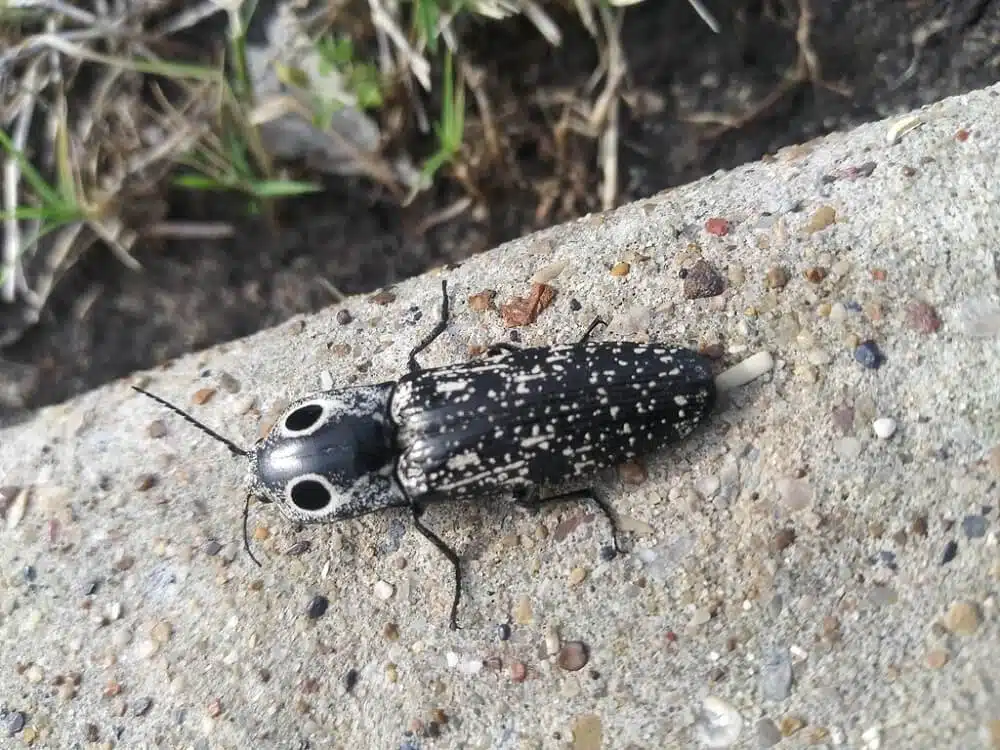
The Texas Eyed Click beetle (Alaus lusciosus) is one of the species with multiple techniques of evading predation which include self-mimicry.
Self-mimicry involves having large black eyes on the top of the head which are fake eyes or simple black dots.
The beetle can also catapult itself with a distinct click-like mechanism that allows it to escape any type of immediate danger.
Common in Texas, the beetle is among the species that have an expanded habitat in Florida and other Southern states.
Texas Eyed Click beetles are among the black and white beetles in the US that can bite.
Its bite is painful but not dangerous. The bug cannot pierce human skin and the pain associated with the bite tends to go away after a couple of hours.
9. Tumbling Ragdoll

Tumbling Ragdolls (Mordella marginata) have an elongated body with a tail-like long abdomen.
The species has a black dominant color with white spots and other white marks on its head.
Other morphs of the species are also found in the US. This includes a black and red and a black and brown morph.
As its name suggests, the species can tumble. It can tumble its way out of predation whenever wasps or birds try to catch it.
10. Ocellated Tiger Beetle

Ocellated Tiger beetles (Cicindela ocellata) grow to a size of up to 13mm.
One of the most common bugs with a dark color body or even a black body with white dots is simply known as the Tiger beetle.
A dark green body with black lower elytra and white spots is a common US morph of the beetle.
Bugs of this genus have a camouflage-like color and use it to their advantage when looking for food.
The larvae and the adult Ocellated Tiger beetle eat insects.
Adults are both diurnal and nocturnal and can look for insects all day and occasionally at night.
Known for nesting underground, this species is sometimes seen on beaches as it likes sandy terrains or other types of terrains in the proximity of a water source.
11. Inflated Beetle

The Inflated beetle (Cysteodemus armatus) gets its name from the globular shape of its elytra.
This beetle has a round-shaped body that has black, white, and gray coloring on the elytra. It also exhibits hole-like textures on the elytra.
Inflated beetles have a white head.
Common in the Mojave Desert, this species is also seen in different colors. Inflated beetles are also seen in a black or yellow color where yellow dominates the elytra.
Beetles of this genus crawl as they cannot fly.
12. Banded Alder Borer

The Banded Alder Borer (Rosalia funebris) is a species known for its black and white-banded body.
Beetles of the species have an elongated black and white elytra, and black and white banded legs.
With the capacity to fly, it can move away from predators but some people still catch it. This beetle makes a hissing noise when handled by hand.
This species of beetle has a detrimental role in its natural ecosystem.
Adult Banded Alder Borers lay eggs in tree bark.
Emerging larvae end up eating wood and potentially stunting tree growth in time.
13. Hairy Rove Beetle

Hairy Robe beetles (Creophilus maxillosus) have long hairs on their black and white body.
Alternating black and white bands are seen on its body. The Hairy Rove beetle has a black head and black legs.
Hairy Rove beetles are found throughout the US. They also live in Europe in high numbers as well as in East Asia.
These beetles are known for eating carrion.
They have adapted to eat some other species that eat and lay eggs on carrion such as flies as well.
You can see Hairy Robe beetles anywhere in the US with dead carrion. A dead rat or fox may attract this beetle.
14. Checkered Melon Beetle
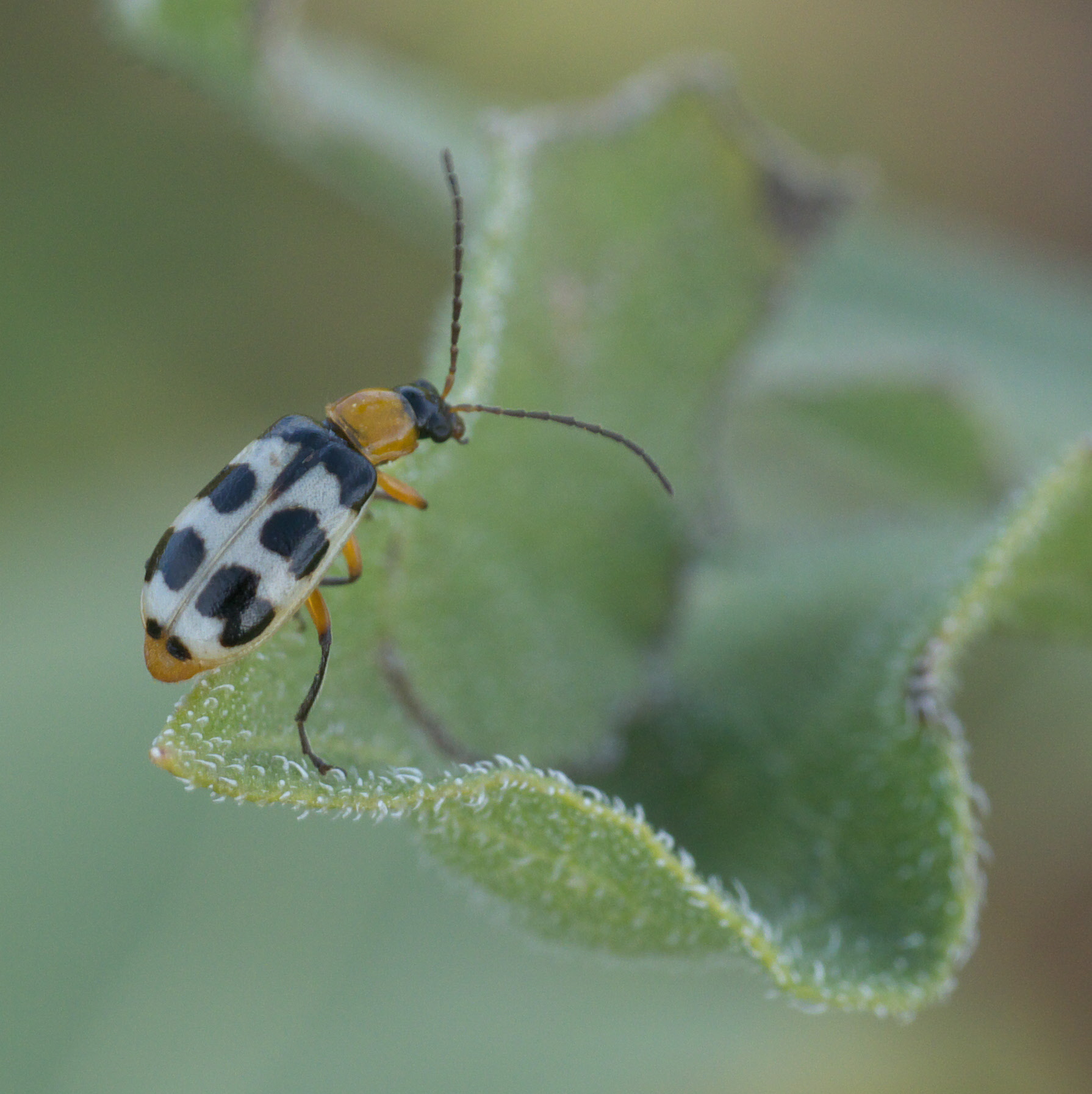
Checkered Melon beetles (Paranapiacaba tricincta) have a tri-colored body. The bugs have brown heads. The elytra are black and white.
4 black spots are visible on each side of the elytra.
Beetles of the genus are known pests on watermelon and cucumbers.
Their numbers are typically reduced by either insecticide or by introducing a predatory species.
15. Eight-spotted Flea Beetle

Eight-spotted Flea beetles (Omophoita cyanipennis) also have 8 spots on the elytra, similar to the Checked Melon beetle.
These bugs have 3 dominating colors. The head is pink-red while the elytra are black with 8 yellow marks.
A small white dot is also visible on the head.
Eight-spotted Flea beetles are diurnal creatures. They feed on various types of plants during the day.
Beetles of this genus mostly eat the leaves of green plants and they can be a common sight as well as a pest in gardens.
Its distribution is widespread in Southern states.
16. Common Asparagus Beetle

The Common Asparagus beetle (Crioceris asparagi) is one of the serious pests of asparagus. It can be found on asparagus crops as well as on small asparagus plantations in gardens.
The species has black elytra with white spots. It features a red underbelly and a red thorax.
Beetles of this genus only feed on asparagus. They also lay eggs on asparagus which means its damage is considerable.
Adults start eating the outer fibers of the asparagus and continue eating it every day.
In turn, this reduces the photosynthesis capacity of asparagus.
As a serious pest, the Common Asparagus beetle needs to be quickly removed either by hand or by using a gardening hose when seen in the garden.
The species is seen as a major pest with economic impact and crops are protected by insecticide against it.
17. Eastern Beach Tiger Beetle

Eastern Beach Tiger beetles (Habroscelimorpha dorsalis) grow to a size between 13 and 15mm. As their name implies, they live on beaches.
Beetles of this species have an off-white to gray elytra color. Black stripes are further visible on their bodies.
Beetles of this genus also have a black head.
The Eastern Tiger beetle is among the black and white beetles with a decreasing population in the US.
A diminishing habitat is among the main reasons why these bugs are seen reduced numbers over the past few years.
The Eastern Tiger beetle has very specific habitat requirements.
Eggs need to be laid in the sand next to water sources such as on beeches not in deserts where there’s no humidity.
The female Eastern tiger beetle has short abdomen hairs used to establish the humidity level on sand which is used to determine if the habitat is good for laying eggs.
18. Common Willow Calligrapher Beetle

Common Willow Calligrapher beetle (Calligrapha multipunctata) has a ladybeetle-like black and white body.
These beetles have silver-white elytra with black spots and 3 black stripes.
The head and the thorax are also silver-white and black.
The legs of the species are red-brown.
These beetles are a pest of cultivated fields. They can impact large cultivars and are often dealt with by farmers using insecticides.
Common Willow Calligrapher beetles can also be eliminated by introducing and facilitating the presence of natural predators.
These predators include certain wasps, true wasps, and hoverflies.
19. Dogwood Leaf Beetle

Dogwood Leaf beetles (Calligrapha philadelphica) are very similar to Common Willow Calligrapher beetles.
They have a white almost silver body with black spots. Black stripes are further visible on the elytra of the species.
These beetles grow to a size between 7 and 9mm.
Most of them exclusively live on dogwood. Both adults and larvae are seen on dogwood.
It takes up to a few months for eggs to turn into adults. Once emerged, the adult Dogwood Leaf beetle eats dogwood leaves for a few months.
It then enters hibernation or a state of inactivity during the winter months.
Dogwood Leaf beetles are further known for laying many eggs in the summer. Female Dogwood Leaf beetles lay at least 100 eggs per mating season which means reproduction rates are high for the species.
20. Pennsylvania Flea Beetle
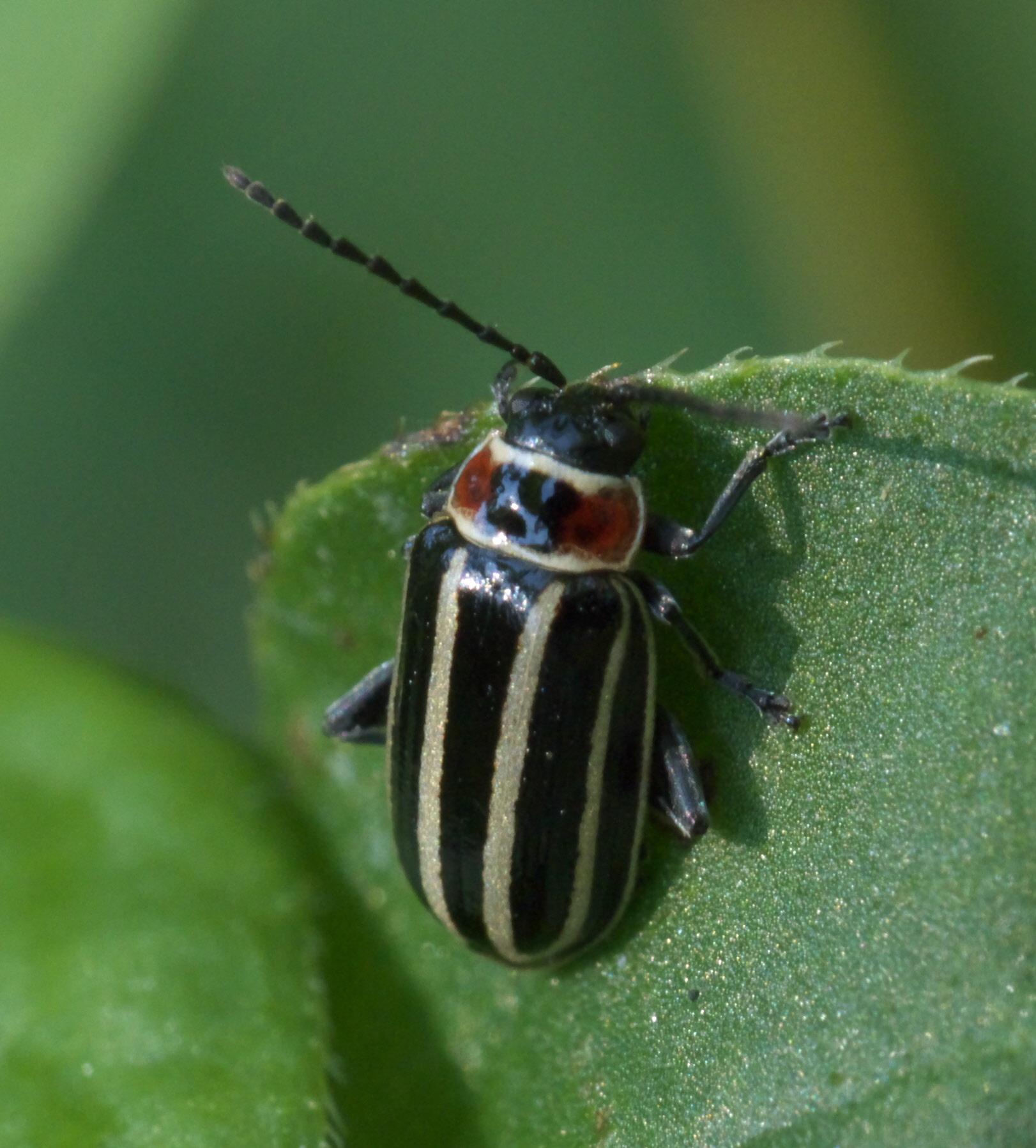
This species of flea beetles (Disonycha pensylvanica) isn’t a major threat to gardens. It lives around wetlands on shrubs and flowers.
These beetles eat leaves and can reach a maximum size of 6.5mm when there’s abundant food in their natural habitats.
They have a black and white body or a black and off-white body, depending on their morph.
The elytra are black and it has 4 contrasting bright stripes.
The thorax is brown while the head is black.
It can be difficult to catch these beetles by hand as they can jump, similar to fleas. Pennsylvania Flea beetles can jump a few times their body size.
21. Elm Calligrapher Beetle
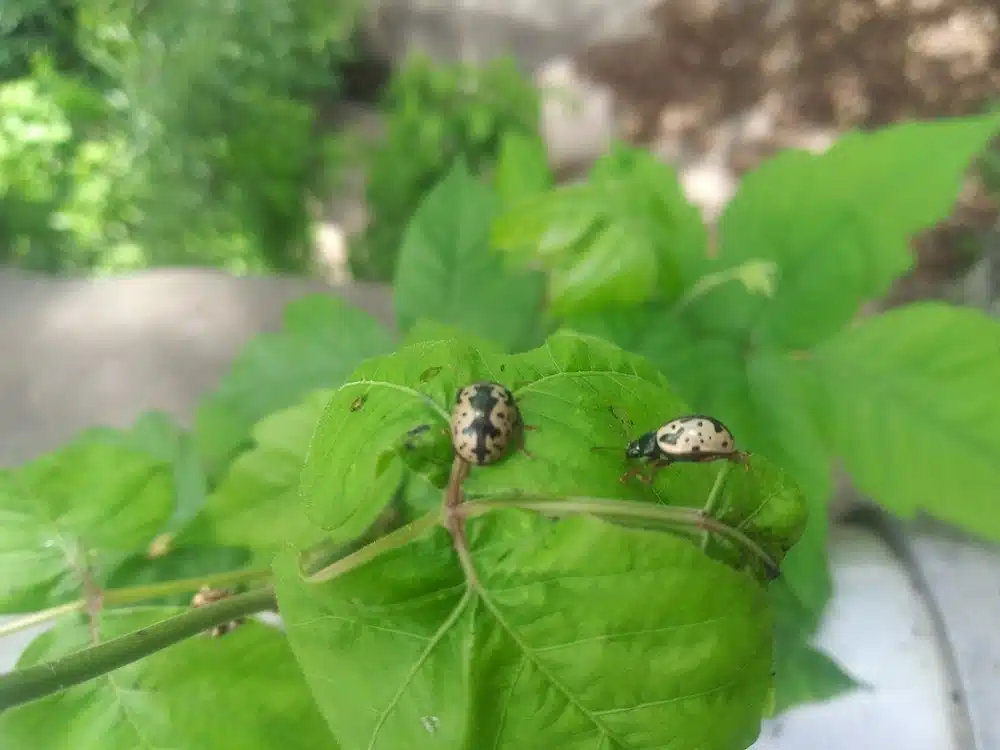
Elm Calligrapher beetles (Calligrapha scalaris) get their name from their host plant, just as other beetles.
These bugs live on the American elm and they prefer to mate and feed on it until the tree gets sick.
Elm calligrapher beetles have a bright color body which can be off-white, gray, silver, or even dark gray.
It has 3 black stripes on the elytra which touch each other unlike the separated stripes on the elytra of other Calligraphers.
Beetles of this species have a black head and black spots on the elytra.
The impact of the beetles on the American elm can be extensive but it can also be negligible.
It’s the larvae of the species that tend to eat entire elm leaves while adults only eat sections of the leaves.
22. Sri Lanka Weevil

The Sri Lanka weevil (Myllocerus undecimpustulatus) has a gray almost white body with faded black marks.
Its head is gray while its legs and antennae are black with small white sections.
These weevils can be a considerable problem for just about any decorative plant in the garden.
Sri Lanka weevils can eat entire plants.
These bugs are known for eating a wide range of green leaves but not those on crops.
The pesticide has limited benefits when it comes to prevention as Sri Lanka weevils efficiently fly away.
Spraying vinegar or soap with water on the plant can be a better solution, especially since these bugs tend to lay eggs in the ground which makes elimination even more difficult.
23. Milkweed Stem Weevil

Mostly black and barely showing white marks on its body, the Milkweed Stem weevil (Rhyssomatus lineaticollis) eats a wide range of milkweeds.
It’s a species directly responsible for endangering many types of milkweed species such as Mead’s milkweed.
This bug has a black color, striations on the elytra, and white-gray marks on the elytra.
It eats milkweeds and a large range of fruits.
24. Fifteen-spotted Lady Beetle
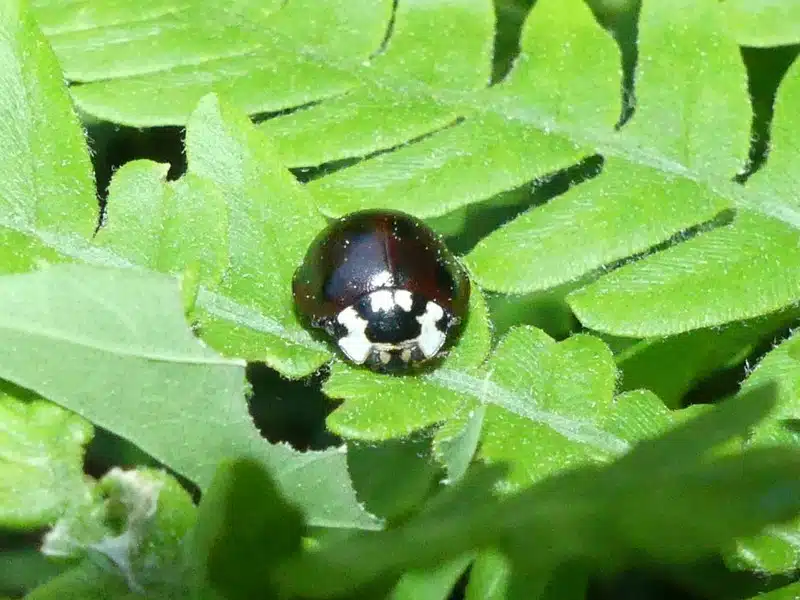
Fifteen-spotted Lady beetles (Anatis labiculata) have a white body with black spots. The head of the species is black.
Bugs of this genus have orange elytra margins and they also have orange-brown legs and antennae.
While small and friendly-looking, the Fifteen-spotted Lady beetle is a predatory species.
It feeds on aphids and other invasive bugs such as scale insects.
25. Moustached Tiger Beetle

This species of beetle (Ellipsoptera hirtilabris) is common in North America and the Caribbean.
It has a distinct pure white color that covers almost its entire body.
A black and gray section is visible on the central elytra which allows the bugs to maintain camouflage and remain undetected.
The reason this bug has an almost completely white color is its preference for living on sandy terrains. It’s which and black coloring helps it blend in.
26. Western Striped Cucumber Beetle
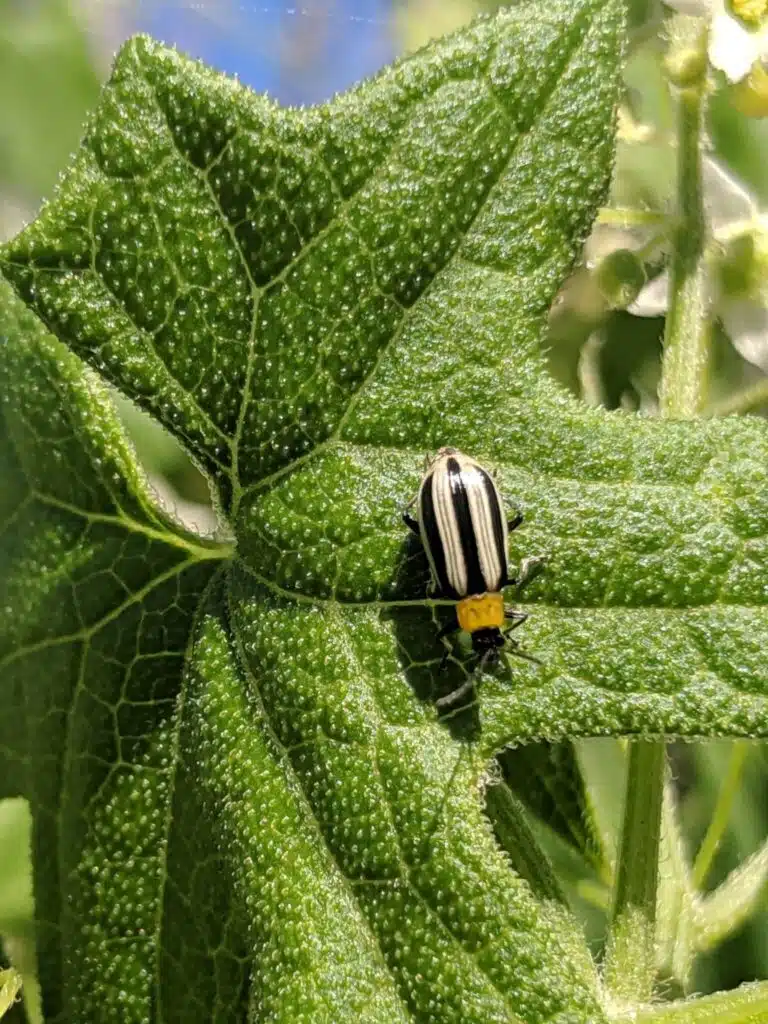
The Western Striped Cucumber beetle (Acalymma trivittatum) comes in multiple morphs.
Its most common color is black and yellow but it also comes in elytra with black and white stripes. The head of the species is yellow-brown.
Western Striped Cucumber beetles are some of the most damaging species on cucumber crops where they eat leaves to the point of killing entire plants.
Pesticides are used to control Western Striped Cucumber beetle populations.
27. Grant’s Hercules Beetle
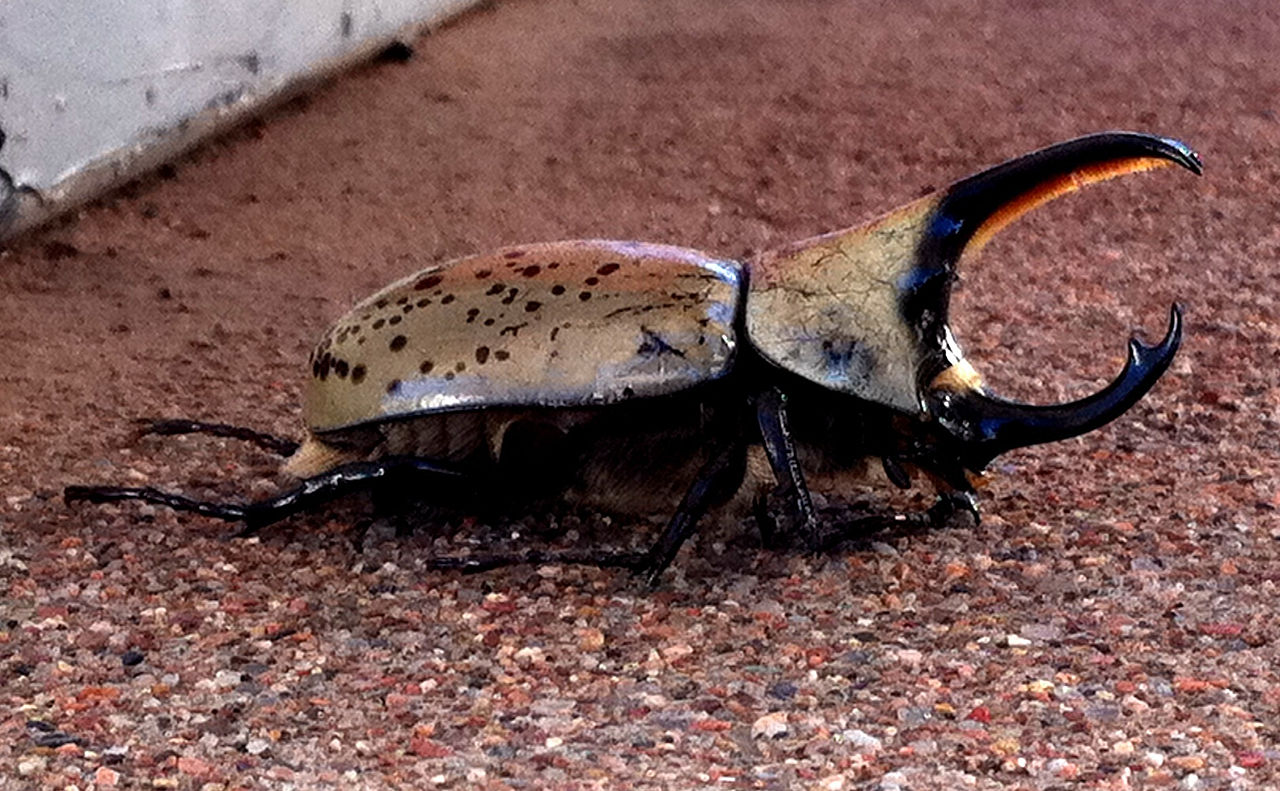
Grant’s Hercules beetles (Dynastes grantii) have a white body with small black dots and black margins on the elytra and around the thorax. These bugs have black antennae and black legs.
Bugs of this genus grow up to 30mm.
They are considered a dangerous species for ash trees in Utah and New Mexico.
Grant’s Hercules beetles feed on the bark and wood of ash trees in the Southwestern US.
28. Bronzed Tiger Beetle

Bronzed Tiger beetles (Cicindela repanda) grow to 13mm.
These bugs have a dark brown body with a black head, a black thorax, and black legs.
White marks are visible on its elytra.
The species is native to North America and it can be seen in the area of The Great Lakes.
Bugs of this genus also live in other sandy areas around the country.
29. Small-eyed Click Beetle

Growing to a size of up to 38mm, Small-eyed Click beetles (Alaus myops) have gray, white, and black bodies.
They have large fake black eyes on top of the head in a form of self-mimicry.
Adult Small-eyed Click beetles feed on a wide range of flowers.
Further Reading: